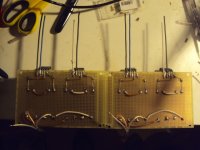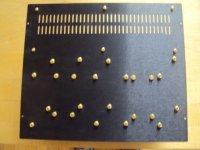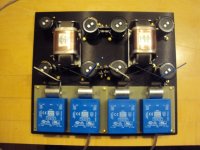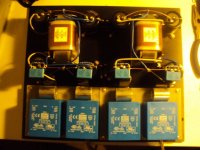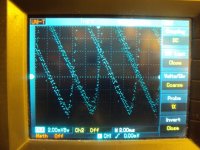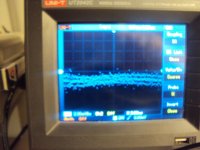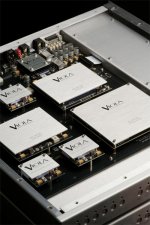My FPS is working!
First hookup done today, after making a new phono cable and opening my LP12 for the x-th time..... And the power supply still not optimal...
The sound is really great, lots of tonal colours in the bass, excellent rhythm, fantastic imaging. I really liked this first trial! The great relaxation however wasn't really there, it sounded like there was some low frequency stuff going on. In the lab, I could measure that in the first 15min from cold there was a lot of DC shifts and thermal settling happening.
Guess it will need to settle in for some time.... And yes, it is dead quiet!
More later when the PS is fixed......
First hookup done today, after making a new phono cable and opening my LP12 for the x-th time..... And the power supply still not optimal...
The sound is really great, lots of tonal colours in the bass, excellent rhythm, fantastic imaging. I really liked this first trial! The great relaxation however wasn't really there, it sounded like there was some low frequency stuff going on. In the lab, I could measure that in the first 15min from cold there was a lot of DC shifts and thermal settling happening.
Guess it will need to settle in for some time.... And yes, it is dead quiet!
More later when the PS is fixed......
Fine, this sounds like a great adventure. Yes, it needs some time to thermally stabilise. Also the Fets in the input. Any new circuit needs some time to settle. The Elcaps have to form etc. Most of the burn in is done in the first 48 hours so i let new circuits on for several days. I also found that the FPS sounds very good in the bass and the NE5534 is a real champ there. I am really happy that you found it to be quiet. I worked really hard on this.
I would be interested if you use the output balanced or unbalanced. When you use it unbalanced : how do you do that ? I also would appreciate a picture of your build. I do not
like to violate your privacy though.
like to violate your privacy though.
No worries.... I will post pictures over the weekend. Input is symmetric as mentioned, output asymmetric unfortunately (using only the positive output into my single ended tube line stage). But I have plans...... My build is not the most beautiful inside though, sorry!
Did I mention there was a huge wealth of micro details and low-level information?
Did I mention there was a huge wealth of micro details and low-level information?
Ward Maas and i are working on a small board with a Thats 1200 balanced to unbalanced converter. That would give the benefit of using both outputs into unbalanced. I can be retro fitted.
Thanks for mentioning that there is a lot of low level information. When i started this thread that somehow also culminated into the FPS a lot of designers out there including Jürgen Ultee, JC, Charles Hansen, Malkolm Hawksford, the late Allen Wright etc., all i respect a lot, told me ( or i saw their comments on the web ) that negative feedback into the input of a low level phono stage could destroy micro detail. I was very careful with the FPS that this does not happen.
Maybe the reason is the discrete Instrumentation Amp topology that amplifies the DIFFERENCE of the input signal and by that avoiding common mode distortion and resolution problems. I was even in the mean time able to design a single ended phono stage with only N-Channel Fets that does not suffer from the low level problem and has negative feedback to the input too but that is another story. Still i think the FPS is a classic that will survive many years. It is the only stage i know that is balanced all the way including a "double" RIAA and it has proven conclusive that negative feedback can be used in low level input stages to advantage ( very low static distortion ) without loss of transparency or low level detail.
Thanks for mentioning that there is a lot of low level information. When i started this thread that somehow also culminated into the FPS a lot of designers out there including Jürgen Ultee, JC, Charles Hansen, Malkolm Hawksford, the late Allen Wright etc., all i respect a lot, told me ( or i saw their comments on the web ) that negative feedback into the input of a low level phono stage could destroy micro detail. I was very careful with the FPS that this does not happen.
Maybe the reason is the discrete Instrumentation Amp topology that amplifies the DIFFERENCE of the input signal and by that avoiding common mode distortion and resolution problems. I was even in the mean time able to design a single ended phono stage with only N-Channel Fets that does not suffer from the low level problem and has negative feedback to the input too but that is another story. Still i think the FPS is a classic that will survive many years. It is the only stage i know that is balanced all the way including a "double" RIAA and it has proven conclusive that negative feedback can be used in low level input stages to advantage ( very low static distortion ) without loss of transparency or low level detail.
Ward Maas and i are working on a small board with a Thats 1200 balanced to unbalanced converter.
Very nice chip -- available from Mouser in the US for ~$6 (SMT only).
I have now fitted the bridges and the Teflon x-caps. I use 1,5mm diameter virgin copper solid core for wiring. The trick is to push down the cable during soldering and make sure that several "eyes" of the perf. board are in contact for good mechanical stability. Otherwise they can come loose over time. The solid core cables are quite stiff. I wired the high power part separate for each channel. Maybe i do even two separate power outlets so the Pre-Regulater needs 2 power cords. I straightened
the solid core cables and made sure that the inner cables of the high voltage sections are not cut to prevent short circuits or oxygen penetration.
See also a photo of the underside. Looks kind of good too. I do not have any fancy tools so drilling the holes with the required precision needs a good eye and a steady hand.
Photos next time.
the solid core cables and made sure that the inner cables of the high voltage sections are not cut to prevent short circuits or oxygen penetration.
See also a photo of the underside. Looks kind of good too. I do not have any fancy tools so drilling the holes with the required precision needs a good eye and a steady hand.
Photos next time.
Yes, that sounds logical. I would argue that most of the critical amplification happens in the input stage, and it is here where the micro details are preserved or lost. And that is where the FPS shines, so to speak. So I can only applaud the careful input stage design (yes I have read pretty much all of the MPP thread and tried to follow with all the evolution that has happened - can't claim that I understood or remember every detail, though ;-)
That being said, n- and p-channel input devices are different, and I wonder if a differential input structure with p/n or n/n would be better. The n/n stage would have most similar behaviour at this first critical amplification step, which the INA would even out later, I think. I think I want to try that one day. That would also be a topology suitable for tubes.
Sorry for the ramblings, but with a nice dinner in the stomach and some montalcino in the head I tend to get philosophical.......
That being said, n- and p-channel input devices are different, and I wonder if a differential input structure with p/n or n/n would be better. The n/n stage would have most similar behaviour at this first critical amplification step, which the INA would even out later, I think. I think I want to try that one day. That would also be a topology suitable for tubes.
Sorry for the ramblings, but with a nice dinner in the stomach and some montalcino in the head I tend to get philosophical.......
A differential stage has low distortion and good DC stability but more noise for the same amount of input devices. I already sacrifice 3dB in the FPS for the sake of no common mode distortion and no hum pick up if the wiring is done correctly. In a differential you loose 6dB and i found that too much. Anyway, some here find even a single NE5534 low noise enough for an MC input. Read the review of the LFD phono stage in Stereophile.
It´s free on the webside. The NE5534 alone has 3.5nV/qHz against 0.5nV/qHz in the FPS although with a higher 1/f frequency due to the physical properties of J-Fets. High frequency noise in the FPS is of a more "benign" quality though because the soft sound the Fets make ( no shot noise ) and the shunt feedback arrangement. Give and take this is a substantial 14db difference between the single NE5534 and the FPS. Now you see how neurotic i got against noise. The AD797, LT1028 crowed is 6dB worse against the FPS. Many stages have that kind of input section and are described in popular magazine reviews as "Ultra Low Noise". This is simply not true.
Again an attempt to upload the Pre-Regulator pictures.
It´s free on the webside. The NE5534 alone has 3.5nV/qHz against 0.5nV/qHz in the FPS although with a higher 1/f frequency due to the physical properties of J-Fets. High frequency noise in the FPS is of a more "benign" quality though because the soft sound the Fets make ( no shot noise ) and the shunt feedback arrangement. Give and take this is a substantial 14db difference between the single NE5534 and the FPS. Now you see how neurotic i got against noise. The AD797, LT1028 crowed is 6dB worse against the FPS. Many stages have that kind of input section and are described in popular magazine reviews as "Ultra Low Noise". This is simply not true.
Again an attempt to upload the Pre-Regulator pictures.
Attachments
Do not worry about the difference in the N and P channel devices. It boils down to a 6 : 7 difference in Gm. I even made an open loop stage with 6 p-channels and 7 n-channels, all with 10mA IDss to study the phenomenon. The difference is rather academic and can be trimmed away with a pot meter in the sources to ground. What happens is a tiny bit more K2 and that can sound even better because a totally symmetric stage has only K3 if done correct but also higher harmonics sometime if there is an unfortunate miss match. See PMA´s webside for a study on that. Unfortunately the study is not complete but that is what PMA says too so he ain´t no lier. In the FPS i use tremendoes amounts of feedback so any miss match is moot.
I have now wired the pre-regulator board. I am very satisfied with my build. DC voltage at the output is exact 38.5V on all 4 channels. I think that speaks volumes for the quality of the inductive parts and the low impedance wiring. The common mode chokes are very effective. See the waveform before and after the chokes. Resolution of the plots is 2mV, 2msec. I will build at least another one. This time for me. I have chokes and the slit foils but may not use Silicon Carbite diodes and teflon snubbers so this build here will be unique until the day comes and somebody totally crazy orders one more.
Attachments
You got the DSO on dot display mode? Effective pre-filtering result. The weird hash stuff is capable of intruding almost any layout, and no CCS is a better firewall than a resistor load for such gremlins. So a good filter is going the extra mile indeed. An expensive mile non the less.
Yes, it is on dot display and i get double traces at that low voltage. I could try to improve the triggering but i am used to that view. One square is only 2mV and this is not a high end scope by any means. I have much better equipment in my professional lab but this is DIY and i do not want to bore and frustrate people by showing of stuff they do not need and they can not afford. I could not afford that stuff for privat use ether.
In the tubes section and in the photo threads there have been very expensive passive PSUs with common mode chokes, very expensive OPTs, etc. Don't worry, its nice to show concepts and builds.
Yes, the tube guys tend to take great care with all things that coil. Since opamps got popular in the late 70th this know how got lost in commercial manufacturing. Even the most wimpy PSU can drive an OP and sound comes out of it. Even i was sceptic but this build convinced me ones and for all that R-C-L filters is the kings way so to say. You will be surprised what comes after that. 4 Sjöström super regulators plus 4 on board shunt regulators by Sigurd Ruschkowski plus constant current sources, precision mirrors and triple crossed cascodes. The only commercial company today that uses big chokes in SS equipment is Viola i think. Cello had that too.
